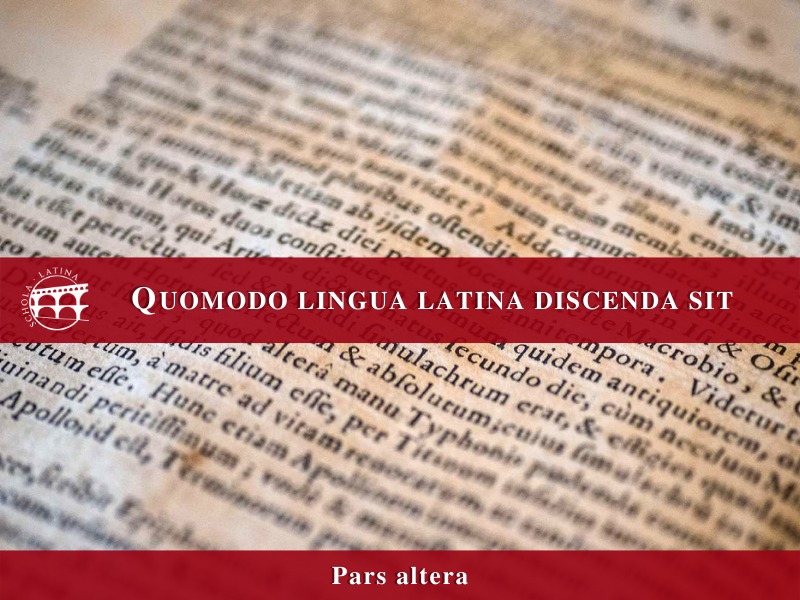Vere novo, vobis monstrare cupimus imaginem lacunariorum Arae Pacis, quam curavit exstruendam Augustus, ut memoriae proderet victoriam suam de populis circa Mare Nostrum incolentibus. Constructio conscita est a. d. III Id. Iul. anno XIII ante Christum natum, et ara ipsa dedicata a. d. III Kal. Feb. anno IX ante Christum natum: qui dies Liviae natalis erat, uxoris imperatoris. Facta est ex marmore Carrariensi, neque secus atque templum minus, in quibus sacrificia rite perpetrabantur.
Dividitur in lacunaria, ex quibus vobis unum ostendimus (vide imaginem I), in quo depingitur Tellus dea, id est, terra ferax et fertilis. Ornatur maeandris, qui sunt fasciae quibus lacunaria superiora ab inferioribus seiunguntur, atque cingitur columnis corinthiis (nam earum capita acanthum perhibent). Per columnas autem impressa sunt inaurium simulacra, abundantiae et fertilitatis signa, quae saepe inveniuntur in monumentis huius aetatis, eo quidem consilio, ut testimonium perhibeant ubertatis quae sub Augusti pacifico imperio viguit; earum commensuratio, illis amoenis locis bucolicis quos Vergilius in Ecloga IV describit quodammodo similis, consensum huius aurei aevi nuntiat. 
In medio posita est Tellus, quae sedet, induta pallio (χιτῶνι), una cum duobus infantibus qui in eius gremio quiescunt, iuxta plena fructuum et florum serta. Ad dextram puer malum tenet manu, post eum spicarum et papaverum fascem ipsa Tellus habet. Spicae consecratae sunt Cereri, agrorum cultui praefectae, quae hanc artem docuit Triptolemum, qui dein hominibus eam tradidit. Papavera vitam simulque mortem declarant, nam somnum gignunt, qui est consanguineus leti, ut Vergilius monet in versu CCLXXVIII libri VI Aeneidos. Sub dea iacent bos et agnus, qui omnium rerum copiam nuntiant.
Deae latera claudunt duae nymphae sive aurae velatae, sic nominatae quia similes sunt tenuibus flatibus. Hae dum oscillant, a terrestribus atque marinis animalibus circumdantur. Terrestris nympha laeva in cycno insidet; infra eam amnis aquarum ex vase diffluit, quod quidem signum tralaticium est fluvialis loci, atque iuxta situm est cannetum, quod cursus fluminis imago est. E regione est aura marina, quae super monstrum marinum insidet. Haec signa advocant “Saturnia” illa “regna” quae cecinit Vergilius in ecloga IV. 
Etiam ima lacunaria (vide imaginem II) inauribus ornantur quae vulgo ‘a candelieri’ (sub specie candelabrorum) vocantur, namque similes sunt foliis pampineis, sic dispositae ut candelabra. Circa folia est animalium multitudo: ranae, volucres, scorpiones et serpentes ibi conspiciuntur. Intus bucrania depicta sunt, necnon coronae et calices. Crania boum sunt earum victimarum quae rite immolabantur, ideoque religionem et mores maiorum monstrant, id est, pietatem. Cetera, id est, calices et coronae, rerum affluentiam et felicitatem indicant: nam fructus et flores specimen sunt vicissitudinum vitae, mortis et renascentis naturae.
Eduardus Arturus Flores Miranda scripsit
In view of the incoming spring, we would like to display an image of one of the relief panels of the ‘Ara Pacis’, the altar of Peace, which was constructed by Augustus in order to commemorate the conquest of the Mediterranean lands. Its construction was ordered on July 4th in the year 13 B. C., and its ‘dedicatio’ took place on January 30th, 9 B. C., which also happened to be the birthday of Livia, Augustus’s wife. It was made with Carrara marble and constitutes a genuine altar, since it is a ‘templum minus’, like those employed to perform sacrifices.
In the centre of the composition Tellus is seated, wearing a chiton (χιτών) or tunic, with two children on her lap, next to a garland with flowers and fruits. The child on the right has an apple in his hand, and behind him there is a handful of spikes and poppies held by Tellus herself. The spikes are a symbol of Ceres, the goddess of agriculture, who taught the art of cultivating the fields to Triptolemus, who soon afterwards shared it with men. Furthermore, poppies are a symbol of life and death, because they induce sleep, which is recognized as death within life (‘consanguineus leti sopor’, Vergil, “Aeneid”, VI, 278). Beneath the goddess there are a bull and a lamb, pastoral symbols of prosperity.
The goddess is accompanied by two nymphs (‘aurae velatae’), one on either side: they represent the winds, and both swing surrounded by terrestrial and marine elements respectively. The terrestrial ‘aura’, on the left, is seated on a swan, and beneath her there is a vessel from where water springs (this is an iconographic convention that represents a river), as well as a spot full of reed, meaning the fluvial setting. On the other part the marine ‘aura velata’ is seated on a marine monster. Without any doubt, these symbols comply with the ‘saturnia regna’ sung by Vergil in his IV eclogue.
The lower panels (like the one shown in figure 2) are also ornated with tendrils ‘a candelieri’ (in the fashion of candlestick holders): they form decorations with grapevine lobed leaves, arranged like candlestick holders. Around the foliage there are plenty of animals: frogs, birds, scorpions and snakes. Inside ‘bucrania’ (bull skulls) are depicted, as well as festoons and goblets. The first ones represent the head of the animals to be sacrificed: they convey a ritual meaning and evoke the traditional religion and customs such as piety (‘pietas’). The second ones mean abundance and plenty, for they include fruits and flowers which represent the life cycle, death and rebirth.
Eduardus Arturus Flores Miranda







Leave A Comment